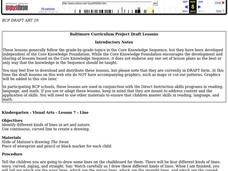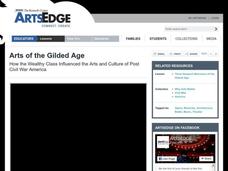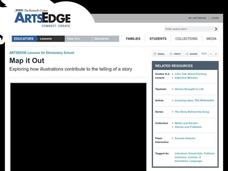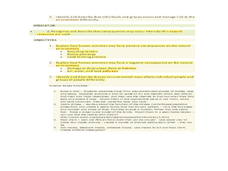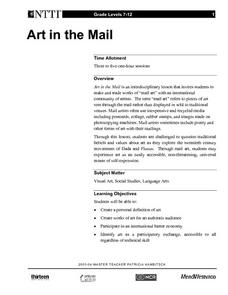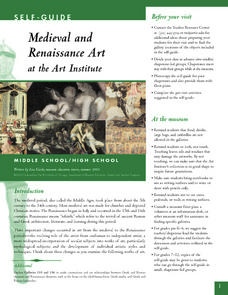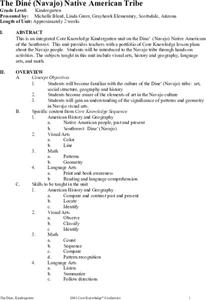Curated OER
Visual Arts
Students identify different kinds of lines in art and nature. They use continuous, curved line to create a drawing.
Curated OER
Arts of the Gilded Age
Learners study the art forms of the Gilded Age. In this integrated arts lesson, students research the art, music, dance, and drama of the historical era and then create their own personal projects that exemplify the time period.
Sargent Art
Destination Art: Paper Mola Collage
The Kuna Indians hail from the San Blas Island near Panama. Learners will investigate their culture by creating paper mola collages, just like the ones created by the indigenous Panamanians. They'll focus on understanding the symbolism...
San Francisco Symphony
Instrument and Visual Appreciation of Art
There are a lot of great ideas to be found here. To better understand the connection between art and history, learners research several music and art pieces, then relate them to major social events. They study the lives and works...
Curated OER
Map It Out
Explore how illustrations add to a story. Young learners will look at picture books to see how the pictures tell the story. They create illustrations to go with a chosen story, and then flip the activity so they have to write a story to...
Curated OER
African Ecology and Art
Explore Samburu culture as students examine art work by many artists and compare and contrast their styles. They view Kenyan images and find Kenya on the map. Students identify conflict in the animal world and draw animals and record in...
Curated OER
Art in the Mail
The "mail art" phenomena was started back in the 20's with the Dada and Fluxus art movements and revitalized in the 60's. The principle of mail art, is free exchange and artistic expression. Learners study these facts and then create...
Curated OER
The Art and History of Japanese Calligraphy
Chinese and Japanese calligraphy is beautiful and significant in both culture and tradition. Engage your class in this expressive fine art form through a lesson on using, holding, and creating brush strokes common to Japanese writing...
Maryland Department of Education
The Concept of Identity Lesson 8: Propaganda in Visual Media
Visual and print propaganda are featured in a lesson that asks readers of A Separate Peace to examine the techniques used in propaganda from World War I, World War II, presidential elections, and in the novel.
Curated OER
The Affect of Music on Visual Images
Eighth graders consider cross-curricular connections between social studies, singing, and current events. They listen to the song, "I Can't Cry Hard Enough." view scenes from September 11, then create presentations using images, a...
Curated OER
Lesson: Recycle, Repurpose, Recreate!
Before youngsters use items from the recycle bin to create unique repurposed sculptures, they should analyze some art. Here, they learn about Francis Nnaggenda, an assemblage artist from Uganda. They analyze one of his sculptures,...
EngageNY
Creating a Visual Component for the Speech: End of Unit Assessment Preparation and Practice
Eye contact, volume, pronunciation. Working with partners, scholars practice presenting their speeches about the best food chain. Additionally, they choose a visual component to support their end-of-unit speech.
Curated OER
Compare and Contrast Photograph Art
Take a trip down Pearblossom Highway with this lesson about comparing and contrasting. Using David Hockney's Pearblossom Hwy and another image of the same highway (photograph or other image), students compare and contrast the two...
Curated OER
Elements of Art - Memoir Book
Learn and practice the elements of art by making a picture book. Also containing short memoirs of their own lives, this would be a perect project and also a gift to take home. In doing this project, they also gain an understanding of the...
Curated OER
Medieval and Renaissance Art at the Art Institute
Students examine several Medieval and Renaissance works of art, including painting and sculpture, at the Art Institute of Chicago. They use worksheets and discussion questions to enhance their interpretation of the pieces.
Curated OER
Splat! Boom! Pow! the Influence of Cartoons in Contemporary Art
Students relate abstract expressionism and cultural influences on 1960's art. They use images appropriated from comic books to create a painting in the abstract expressionist style by changing the scale of the comic and reducing content...
Curated OER
Design Life: Exploring Society Through Art
Introduce learners to the design elements and artifacts of interior environments in Victorian Canada (or any people and era you care to explore) based on artwork that represents their world. Your secondary social historians view the art...
Curated OER
Explore Cultural Diversity Through Art
Explore cultural diversity and build tolerance. Learners view art representing various cultures by Canadian painters. (Adapt with images or artists that reflect your demographics.) The class creates a collage or mural depicting cultural...
Curated OER
The Díne (Navajo) Native American Tribe
Students participate in a variety of activities to become familiar with the Navajo Indians. In this Díne (Navajo) Native American tribe lesson, students understand where the Navajo tribe lived and find them on a map. Students discuss the...
Curated OER
Visual Art - Creating a Clay Pinch Pot
Sixth graders inspect various clay pots. They create their own pots and paint them in the horror vacui design.
Digital Dream Lab's Art Game Swatch Out!
Why did we create an art game? Teachers reported to us that students struggle in art the most with composition of colors. For example, students often think "pink" is composed of random colors or that pink is its own color, instead of...
Dick Blick Art Materials
Start with a Circle...
The Golden Ratio. The Divine Proportion. Yup. It's math and art blended into one colorful activity. Young artists combine colored tissue paper circles and parts of circles to create geometric patterns. As a bonus, kids get to figure out...
Curated OER
Creating Your Own Rock Art
Eighth graders look at early art. In this visual arts lesson, 8th graders investigate the attributes of rock art, examine rock art, and create their own examples of rock art. Analysis and instructional worksheets are included.
Curated OER
Basic Visual Language Ii: How To Analyze a Visual Text
Students identify techniques used to communicate visually. They compare and contrast different visual techniques found in mass media. They apply their understanding by creating photographs that use a variety of visual literacy techniques.


